The Checker Maven
The World's Most Widely Read Checkers and Draughts Publication
Bob Newell, Editor-in-Chief
Published every Saturday morning in Honolulu, Hawai`i
Noticing missing images? An explanation is here.
Back to School, 2009

Yes, it's that time of year again, when to the general dismay of young folks everywhere, school opens again for another seemingly endless academic year. We counsel students to take courage and persevere--- it isn't really all that bad, and you will be repaid many times over in the years to come.
Our continuing Checker School lessons also offer much reward, and the effort involved is most enjoyable. This month, as we continue with studies drawn from Ben Boland's Famous Positions in the Game of Checkers, we look at three positions that seem unlike each other, but have a definite relationship that you'll understand as you study the solutions and notes.
In Mr. Wardell's study, Black has even material but a position that looks hard to defend, yet somehow must manage to draw
WHITE
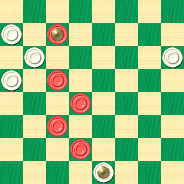
BLACK
Black to Play and Draw
B:W28,24,21,20,K2:BK27,19,15,11,7.
In the second study, by Mr. Grey, Black is a piece down and seems to need a miracle.
WHITE
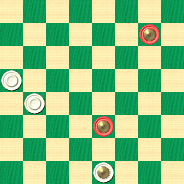
BLACK
Black to Play and Draw
B:W20,16,K2:BK25,K10
In the final study, by Mr. Hennigan, Black has even material but a rather tough-looking position, yet the draw is there.
WHITE

BLACK
Black to Play and Draw
B:W30,29,K24:B27,23,22.
Spend some time on these; after all, good lessons require effort! When you're ready, click on Read More for the solutions, sample games, and detailed study notes.![]()
Monty's King-Pinch

In the English language, the word "pinch" has a couple of different meanings. The young lady above is demonstrating the most common meaning, pinching her cheeks in a manner that we're sure she finds amusing. But today, we're going to consider another meaning of the word, namely, "to steal."
In our continuing series of excerpts from Willie Ryan's famous book, Tricks Traps & Shots of the Checkerboard, Willie talks about Monte Schleifer's clever way of stealing, or pinching, a king, via a most interesting stratagem. Willie tells us more below.
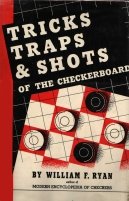
"When I was a schoolboy of 13, I learned that the City College of New York had organized a checker club for students, and were holding weekly meetings every Friday afternoon. On my initial visit to this club, I had the pleasure of meeting for the first time Monte Schleifer of Brooklyn and Jack Cox of the Bronx. Today, they rank high among the nation's leading player-analysts. As a special contribution to this book, Monty offers this attractive morsel of brilliant play, showing a clever drawing idea. For the diagram, move:
| 11-15 | 10-14---A | 4-11 |
| 24-19 | 27-24 | 24-19 |
| 15-24 | 16-20 | 6-10 |
| 28-19 | 31-27 | 29-25 |
| 8-11 | 7-11 | 12-16 |
| 22-18 | 19-15 | 19-12 |
| 11-16 | 2-1---B | 10-15. |
| 25-22 | 15-8 |
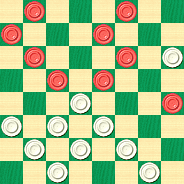
WHITE
White to Play and Draw
W:W32,30,27,26,25,23,22,21,18,12:B20,15,14,11,9,7,5,3,1.
A---The following unusual shot came up in a mail game between Joseph Viera of Nantucket, Massachusetts, and Fred Butterworth of Passaic, New Jersey: 4-8, 22-17, 8-11, 17-13, 16-20, 26-22, 11-16, 29-25, 9-14, 18-9, 5-14, 22-18, 14-17, 21-14, 10-17, 31-26, 7-10, 18-15, 3-8, 23-18, 16-23, 26-19, 17-22, 25-21, 10-14, 18-9, 1-5, 15-11 (what's going on here?), 8-31, 30-26, 5-14, 26-1; a draw. A well-played crossboard game.
B---Strongest, but 4-8, 29-25, 2-7, 24-19, 7-10, 32-28, 12-16, etc., also seal the draw."
Can you figure out how Monty pinches a king? When you've worked out your solution, click on Read More to let Willie show you how it's done.![]()
Christie's Shot

In our photo, it looks like Christie O'Shea of Ithaca College is about to make quite a shot. Obviously, that would be a golf shot. Although we know Christie is a top-notch golfer, we don't know if she plays checkers; and our subject for today is of course a checker shot known most appropriately as "Christie's Shot." However, that's Henry Christie of Great Britain ... and we're getting ahead of ourselves. Willie Ryan, in his classic Tricks Traps & Shots of the Checkerboard presents both the history and practice of this deft maneuver. Let's let Willie take over the narrative.

"In the 1891 English Tourney, Champion Henry Christie hooked J. L. Richmond on the following blitzer, and ever since it has been known as the Christie Shot. However, some authorities claim Charles Hefter dropped J. P. Reed on the same scoop prior to 1891. Actually, the Christie Shot was first shown by E. Jacques of Malvern, Ont., Canada, in 1865, bringing up the stroke from a Cross game. Hence, Jacques was first. But it remained for Christie to give the coup historical significance. In this book, I have followed the policy of several authors, by labelling the stroke on the next page 'Christie's Shot,' so as to distinguish it from the Jacques Shot on page 95.
| 11-15 | 23-18 | 4- 8 |
| 22-18 | 6-10 | 19-15 |
| 15-22 | 25-21 | 6- 9 |
| 25-18 | 10-17 | 23-19 |
| 12-16 | 21-14 | 17-22 |
| 29-25 | 2-6---A | 26-17 |
| 9-13 | 26-23 | 9-13 |
| 18-14 | 13-17 | 15-10---C |
| 10-17 | 31-26 | 13-22 |
| 21-14 | 8-11 | 19-15. |
| 16-20 | 24-19 |
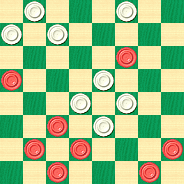
BLACK
Black to Play and Win
B:W32,30,28,27,18,15,14,10:B22,20,11,8,7,5,3,1.
A---Black can shoot for an alternative fast win by: 1-6, 26-23, 13-17, 31-26, 6-9, 24-19, 9-13, 14-9---B, 5-14, 18-9, 2-6, 9-2, 17-22, etc.
B---Into the cauldron! The correct sequence for a draw is: 19-15---1, 17-22, 26-17, 13-22, 14-9, 5-14, 18-9, 22-26, 9-5, 26-31, 5-1, 31-24, 28-19, 20-24,1-5, 8-11,15-8, 4-11, 5-9, 7-10, 9-13,11-15, 23-18, 15-22, 13-17, 22-26, 30-23, 24-27. J. Tonar.
C---Another good game gone wrong. White should play: 19-16, 13-22, 16-12, 1-6, 27-23, 22-25*, 30-21, 7-10, 14-7, 3-26, 12-3, 6-9, 3-7, 11-16, 32-27, 9-14, 18-9, 5-14, 7-10, 16-19, 10-17, 26-31; a draw. F. C. Oakley."
1---28-24 also draws---KingsRow.
Can you "drive" to a win, or have you "sliced" off a little too much? You can always "hook" the solution by clicking on Read More to see the proper follow-through.![]()
The Triplets

The triplets shown above have already graduated from school, so they won't need to study today's extensive Checker School lesson... if their degrees happen to be in checkers, at least. If you don't yet have your graduate's diploma in checkers, perhaps then you might wish to pay close attention in class. The checker "triplets" we'll set out are known as the Bowen Triplets, presumably because there are three related positions with three pieces on each side. In addition, we have nine other, similar positions, all of which also involve three pieces per side.
Let's see, that's three pieces per side, six pieces total, twelve positions in all ... we had better stop there and just present our material, which comes from Ben Boland's classic text Famous Positions in the Game of Checkers.
Note: for the sake of consistency, in all positions White is at the top and Black at the bottom, regardless of who is to move.
| R. E. BOWEN 1 | R. E. BOWEN 2 | R. E. BOWEN 3 |
| WHITE | WHITE | WHITE |
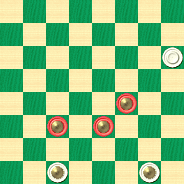 | 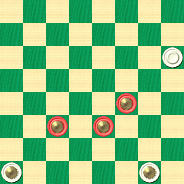 | 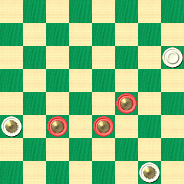 |
| BLACK | BLACK | BLACK |
| Either Plays, Black Wins | Either Plays, Black Wins | White to Play and Draw |
| Black to Play and Win | ||
| B:W21,K3,K1:BK14,K11,K10. | B:W21,K4,K1:BK14,K11,K10. | B:W21,K12,K1:BK14,K11,K10. |
| Dr. T. J. BROWN 4 | J. GORDON 5 | E. CLARK 6 |
| WHITE | WHITE | WHITE |
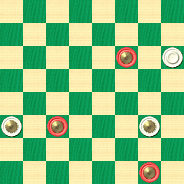 |  | 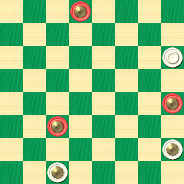 |
| BLACK | BLACK | BLACK |
| White Plays, Black Wins | Black to Play and Win | White to Play and Draw |
| W:W21,K12,K9:BK22,K11,K1. | B:W21,K20,K5:BK19,K18,K14. | W:W21,K5,K3:BK31,K13,K11. |
| D. MILLIGAN 7 | B. TAYLOR 8 | J. K. LYONS 9 |
| WHITE | WHITE | WHITE |
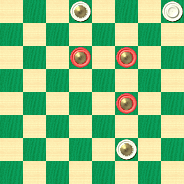 | 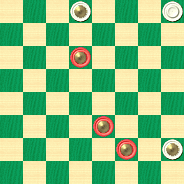 | 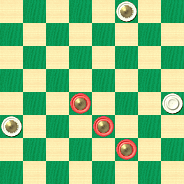 |
| BLACK | BLACK | BLACK |
| White to Play and Draw | Black to Play and Win | White to Play and Draw |
| W:WK31,29,K6:BK23,K22,K14. | B:WK31,29,K5:BK23,K10,K6. | W:WK30,13,K12:BK15,K10,K6. |
| C. NELSON 10 | A. W. VALENTINE 11 | W. J. ZAHL 12 |
| WHITE | WHITE | WHITE |
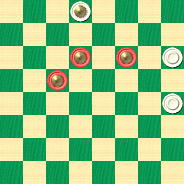 | 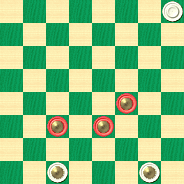 | 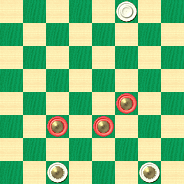 |
| BLACK | BLACK | BLACK |
| Black to Play and Win | White to Play and Draw | Either Plays, Black Wins |
| Black to Play and Win | ||
| B:WK31,21,13:BK23,K22,K19. | B:W29,K3,K1:BK14,K11,K10. | B:W30,K3,K1:BK14,K11,K10. |
It will take you some little while if you wish to work through all of these, but if you take the time and put in the effort, you cannot help but improve your play. So, we suggest that you double--- or better yet, triple--- your efforts and search out the answers. And, for extra credit, if twins are two, triplets are three, and so on ... can you tell us what twelve are called?
When you're done, you can click on Read More to see Mr. Boland's usual detailed solutions and copious explanatory notes, as well as the answer to our trivia question.![]()
Uncle Ben's Porch: Tommy Goes to Brooklyn

It was a hot Saturday morning in June, hot and humid the way only Florida can be. Tommy and Uncle Ben were, as usual for a Saturday morning, sitting on Uncle Ben's porch with a checkerboard and a pitcher of Uncle Ben's incomparable lemonade.
"So, Tommy," began Uncle Ben, "I take it you've never been to Brooklyn before?"

"No, sir," replied Tommy, "but I'm really looking forward to it." Tommy's grade school checker team had done really well the past year in the Southeastern Checker District, and had been invited to play in the Eastern U.S. Regionals, to take place in July in Brooklyn, New York. Tommy, as Captain of the Junior Varsity Team, would be going along as a substitute.
"You know, Tommy, that I spent much of my life in Brooklyn, prior to my retirement. I wrote most of my books while I was there. I think you're going to enjoy your visit, and I hope you'll have time to do a little touring."
"Yes, Uncle Ben, Coach Hovmiller has given us an extra day at the end of the tournament to see the sights, and he's even arranged for a bus to take us to the Statue of Liberty and the Empire State Building!" Tommy paused for a moment. "But most of all, I'd like to get a chance to play, and maybe do well enough to make the Varsity Team next year."
"I was thinking about that," said Uncle Ben, "and today I'd like to give you some practice in visualization that could come in very handy. We're going to take a look at, of all things, something called 'The Brooklyn Stroke.' Quite appropriate, don't you think?"
And with that, Uncle Ben set up the following position on the checkerboard.
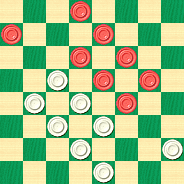
WHITE
Either to Play and Win
W:W14,17,18,22,23,26,28,31:B2,5,7,10,11,15,16,19.
"It's rather unique, Tommy," he said, "in that whoever plays first will win! Can you show me how? Start with White, and then try it with Black."
But Tommy was already deep in thought. It took a little time, and half a glass of lemonade, before he spoke. "Here you go, Uncle Ben!" he said excitedly, and began to move the pieces.

How will you do with this problem? Will half a glass of lemonade do the job, or is it a bit harder than that? When you've solved it--- from both sides, mind you--- click on Read More for the solution, a sample game, and over a dozen additional examples of this theme.![]()
Not Quite PC

Today's offering in our monthly series of excerpts from Willie Ryan's Tricks Traps & Shots of the Checkerboard, entitled Freeman's Flashback, is another entry that in modern terms can't be called "politically correct." Reflecting the approach of a different era, Willie makes a comment that, while innocent in intent, would no longer be considered "acceptable."
We note that we're not ourselves offended by remarks that mean no harm and in fact cause none, and it's our humble opinion that the notion of needing to be "politically correct" has been taken way too far. But that's a topic for a different forum, and we'd much rather let Willie show us another gem of the checkerboard.

"Here is how 'World Beater' Clarence Freeman of Providence, Rhode Island, polished off 'Stonewall' Barker of Boston, Massachusetts, in an American Championship match game, many years ago. Freeman, a full-blooded Pequot Indian, required no tomahawk to 'scalp' almost all of the leading players of his day. Like Reed, he was a brilliant cross-board player.
| 10-15 | 7-10 | 10-17 |
| 21-17 | 26-22 | 28-24 |
| 11-16 | 9-14 | 1-5 |
| 22-18 | 18-9 | 18-15 |
| 15-22 | 5-14 | 7-10 |
| 25-18 | 31-26 | 23-18 |
| 16-20 | 4-8 | 16-23 |
| 17-13 | 22-18 | 26-19 |
| 8-11 | 14-17 | 5-9---A |
| 24-19 | 25-21 | See the |
| 11-16 | 3-7 | diagram. |
| 29-25 | 21-14 |
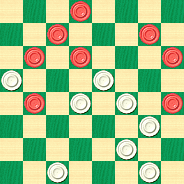
WHITE
White to Play and Win
W:W13,15,18,19,24,27,30,32:B2,6,8,9,10,12,17,20.
A---Barker walks right into the net. The only moves for a draw are: 2-7*, 18-14, 17-22, 13-9, 10-17, 9-2, 7-11, 15-10---1, 11-16, 19-15---2, 22-26, 30-23, 16-19, etc."---3
1---2-7 draws as well---Ed.
2---Or 10-7---Ed.
3---23-16 12-28 27-24 20-28 32-23 to a clear draw---Ed.
You don't need to be "PC" to solve this problem; you just need to be a good checkerist. After you've sought the "correct" expression of the solution, no one will dispute that clicking on Read More isn't the best way of seeing how it's done "correctly."![]()
A Graham Cracker
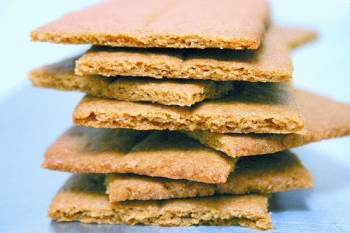
Undoubtedly your school lunch (whether that applies to the current era or to yesteryear) at times contains (or did contain) some Graham crackers. This popular snack was originally invented in New Jersey something like 180 years ago by a Reverend Sylvester Graham, who thought that white flour lead to all sorts of evils not suitable for mention in a family-oriented publication, and that his graham-flour based preparation would save many a wayward soul. But today, sad to say, many so-called Graham crackers don't even contain graham flour! Such is the way of the world.
Today's continuation of our on-going Checker School series, though, is the real thing: a position attributed to a different Graham, old-time checkerist R. Graham, that's a cracker of a problem. While far from being trivial, it's less difficult than most of the problems in this series; and as usual, it's eminently practical.
BLACK
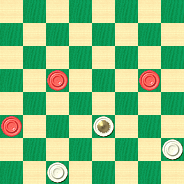
WHITE
White to Play and Win
W:WK23,28,30:B14,16,21.
White certainly has the better position here, including the "move" or opposition. Can you crack this one and bring the White side through to a win, or will you slip up and fall into a crack? Clicking on Read More will show you the solution, a sample game, and the customary explanatory notes.![]()
Jacob's Jinx

Things don't always go right; our soccer players in the photo above are finding that out, it seems. Sometimes when things go wrong over and over in the same situation, we speak of a "jinx." In today's episode from Willie Ryan's Tricks Traps & Shots of the Checkerboard, some skilled checkerists seem to encounter a bit of a jinx of their own. We'll let Willie tell us the story.

"It was in 1905 that two very distinguished Englishmen of the draughts world, Harry Jacob and J. H. Strudwick, of London, produced a fine work on the Kelso opening, showing play on all white replies to 10-15 as an opening move. When the authors arrived at the position diagrammed on the next page, they pulled one of the most glaring boners in checker literature by overlooking the shattering shot revealed at the point of illustration.
The diagrammed position is reached by:
| 10-15 | 8-11 | 9-14 |
| 21-17 | 29-25 | 24-19 |
| 11-16 | 4- 8 | 15-24 |
| 17-13 | 22-17 | 28-19 |
| 16-20 | 7-10 | 11-16---A |
| 25-21 | 25-22 |
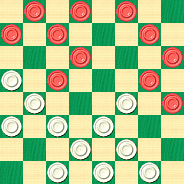
WHITE
White to Play and Win
W:W13,17,19,21,22,23,26,27,30,31,32:B1,2,3,5,6,8,10,12,14,16,20.
A---Recommended by Jacob and Strudwick for a draw, but it loses. The following, however, will gain a draw easily: 11-15---1, 19-16, 12-19, 23-16, 2-7, 16-12, 7-11, 26-23,15-18, 22-15, 10-26,17-10, 6-15, 30-23, 11-16, 21-17, 8-11, 17-14, 15-19, 23-18, 1-6, 18-15, 11-18, 27-23, 19-26, 31-15, 3-7, 15-11, 6-10, etc. Wm. F. Ryan."
1---Deep computer analysis supports this line of play. Willie, of course, did it all on his own---Ed.
Can you find the win that Jacob and Strudwick missed, or will you be jinxed as well? Try your luck and then click on Read More to see the action-packed solution.![]()
Three of a Kind

No, we don't know what they are either! When we think of "three of a kind" playing cards come to mind first, followed by a few other more ordinary images. Our photo is definitely "three of a kind" but the mystery of their identity will remain unsolved.
Today's Checker School entry is also three of a kind; or, at least, three variations on a common checker theme. In each setting, Black has three kings to White's two kings and a man, and it is up to Black to demonstrate a win. It's not an easy task, but the situations are very practical and knowing this theme will score you many an extra point in competitive play.
WHITE
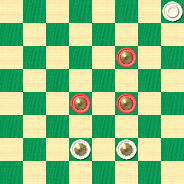
BLACK
Black to Play and Win
B:W29,K7,K6:BK22,K15,K14.
WHITE
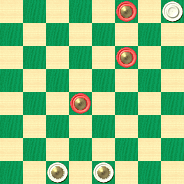
BLACK
Black to Play and Win
B:W29,K3,K2:BK30,K22,K15.
WHITE
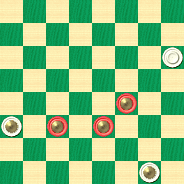
BLACK
Black to Play and Win
B:W21,K12,K1:BK14,K11,K10.
In a sense, if you can solve one, you can solve them all; but it's easier said than done. As a small hint, you may wish to do these in reverse order, starting with the third diagram.
Give it a try, and note that as usual one thing is no mystery: clicking on Read More brings you the solutions, sample games, and many explanatory notes.![]()
Hynd's Hedgehopper

The Hedgehoppers were a relatively obscure band from Durban, South Africa, circa 1971 (just where do we come up with these things?). Quite honestly, we've never listened to their music; and today, we'd wager it would be difficult to find.
Perhaps equally difficult to find is Willie Ryan's classic book, Tricks Traps & Shots of the Checkerboard. Fortunately, we're reprinting sections of it here each month; and in our usual manner, our lead photo and full column have related titles. Today, we bring you Hynd's Hedgehopper, explained to us by Willie himself.

"Here is a good stroke by Champion John Hynd of Manchester, England, which is recorded in every expert's notebook. Hynd, by the way, has been playing top-flight draughts for almost half a century, and is still playing with the best. A former Champion of England, he played on the British team in the 1905 International Match.
| 10-14 | 28-24 | 9-14 |
| 24-20 | 4-8 | 26-23 |
| 6-10 | 23-19 | 2-6 |
| 22-18 | 8-11 | 30-26 |
| 11-15 | 25-22 | 5-9---A |
| 18-11 | 14-18 | See the |
| 8-15 | 29-25 | diagram. |

WHITE
White to Play and Win
W:W19,20,21,22,23,24,25,26,27,31,32:B1,3,6,7,9,10,11,12,14,15,18.
A---Off the beam, and loses. Here is how black should play it: 6-9*, 32-28, 9-13---1, 19-16, 12-19, 23-16, 14-17, 21-14, 10-17, 24-19, 15-24, 22-8, 3-19, 27-23, 17-21, 23-16, 21-30, 28-19, 30-23, 16-12, 23-16, 20-2, 1-6, etc., for a draw; an old combination."
1---Ed Gilbert's King's Row computer engine gives 1-6 to draw here as well, and the continuation is also quite flashy: 1-6 20-16 11x20 19-16 12x19 23x16 15-19 24x15 10x19 22x15 14-18 15-11 18-23 27x18 9-13 11x2 3-8 2x9 5x30 to a draw.
Can you sing and dance your way through this one? Don't worry, sweet music can be had by clicking on Read More, which will take you straight to the solution.![]()
The Checker Maven is produced at editorial offices in Honolulu, Hawai`i, as a completely non-commercial public service from which no income is obtained or sought. Original material is Copyright © 2004-2026 Avi Gobbler Publishing. Other material is public domain, AI generated, as attributed, or licensed under CC1, CC2, CC3 or CC4. Information presented on this site is offered as-is, at no cost, and bears no express or implied warranty as to accuracy or usability. You agree that you use such information entirely at your own risk. No liabilities of any kind under any legal theory whatsoever are accepted. The Checker Maven is dedicated to the memory of Mr. Bob Newell, Sr.

